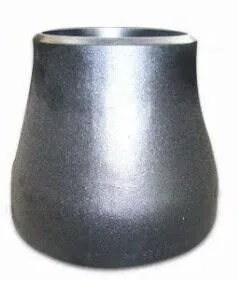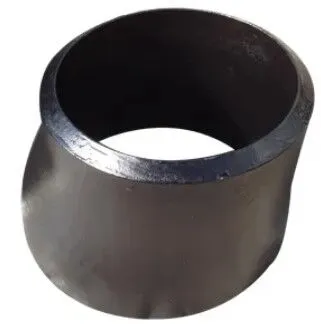In industrial piping systems, reducers are important components used to connect pipes or flanges of different diameters. They help reduce or increase the size of a pipe. There are two main types of reducers: concentric reducers and eccentric reducers. Both serve the same basic purpose, but they differ in design, installation, and their effect on fluid flow. This article will introduce these two types of reducers and discuss their applications, manufacturing processes, and routine maintenance.
A concentric reducer has pipe ends where the centers of the inner and outer diameters are aligned on the same axis. The inner and outer diameters are concentric. In piping systems, when a change in pipe size is needed, concentric reducers keep the pipeline axis aligned. This makes them suitable for gas pipelines and vertically flowing liquid pipelines. The transition in size causes little disturbance to the fluid flow, so concentric reducers have a low impact on fluid dynamics. They are often used in systems that require stable flow and precise fluid flow behavior.

Gas Pipelines: Concentric reducers are ideal for reducing pipe size in gas pipelines. Gas flow is usually stable and changes are minimal. Using a concentric reducer ensures stable fluid flow.
Vertical Liquid Pipelines: Concentric reducers are also used in vertical liquid pipelines. They minimize disruptions to the fluid flow, ensuring smooth movement of the liquid.
An eccentric reducer has pipe ends where the centers of the inner diameters are not aligned. The inner diameter is tangential to the circumference of the pipe. Eccentric reducers have one flat side, making them particularly suitable for applications involving gas or liquid discharge. They help reduce flow fluctuations and prevent air or liquid buildup inside the pipe.
Eccentric reducers are commonly used in horizontal liquid pipelines. There are two common installation methods: top-flat installation and bottom-flat installation:
Top-flat Installation: The flat side is positioned upwards, which is ideal for pump inlets. This installation helps discharge air and prevents cavitation at the pump inlet.
Bottom-flat Installation: The flat side is positioned downwards. This installation is often used for control valve installations. It allows for effective drainage and ensures smooth fluid flow in the pipeline.

Pump Inlets: Eccentric reducers help remove air at pump inlets, preventing cavitation and ensuring stable pump operation. The installation method (top-flat or bottom-flat) depends on the direction of the liquid flow into the pump.
Horizontal Liquid Pipelines: Eccentric reducers are well-suited for horizontal liquid pipelines. They help remove air or liquid and ensure smooth fluid flow. They also make pipeline maintenance easier.
The manufacturing of reducers involves several forming techniques, including expansion forming, contraction forming, and stamping. The choice of technique depends on the design requirements and the amount of size reduction needed.
Expansion Forming: This method uses a pipe billet with a diameter smaller than the larger end. An internal mold expands the inner diameter of the pipe to form the reducer. This method is used when the size reduction is large and contraction forming is not practical.
Contraction Forming: A pipe billet, the same diameter as the large end, is placed in a mold. The metal is compressed along the mold, causing it to shrink and form the reducer. This process can be done in one or more stages, depending on the size difference and material properties.
Stamping Forming: Stamping is used for special specification reducers. The material is stretched using a die to form the required reducer shape.
Depending on the material and size reduction needs, cold forming or hot forming can be used. Cold forming is more common, but hot forming is better for larger reductions or thicker wall sections.
Reducers are used in various situations where a change in pipe diameter is needed. Their main functions include:
Pipe Diameter Reduction: Reducers connect pipes of different diameters. They are commonly used in gas or liquid pipelines. For example, if a 325mm pipe needs to be connected to a 219mm pipe, a reducer with a 325-to-219 transition ensures smooth fluid flow.
Flow Control: Reducers help control the flow of liquid in pipelines. They prevent large flow fluctuations. In systems that require stable flow, reducers ensure a consistent flow rate.
Cavitation Prevention at Pump Inlets: Reducers at pump inlets help prevent air buildup and cavitation, ensuring smooth pump operation.
Flowmeter and Control Valve Connections: Reducers are used to connect flowmeters and control valves, ensuring smooth fluid flow and accurate flow measurement.
Proper maintenance is important to ensure the long-term performance of reducers, especially since they often transport corrosive materials. Common maintenance practices include:
Cleaning and Rust Removal: Regularly clean the reducers to remove rust and impurities from the surface.
Rustproof Coating: Apply a rust-resistant coating to the outer surface of the reducer to prevent corrosion and extend its lifespan.
Periodic Inspections and Repairs: Regularly check the reducer for cracks or deformations. If problems are found, repair them promptly to maintain the integrity of the pipe.
When choosing a reducer, it is important to select the right type and specification based on the needs of the pipeline. Consider the following points.
Pipeline Type: For vertical pipelines, concentric reducers are typically used. For horizontal pipelines, especially those needing air or liquid drainage, eccentric reducers are recommended.
Installation Method: For pump inlet pipelines, choose a top-flat or bottom-flat eccentric reducer based on the direction of liquid flow. For other fluid control systems, choose the appropriate reducer based on the process requirements.
Both eccentric reducers and concentric reducers play important roles in pipeline systems. Each has unique design advantages and application scenarios. Choosing the right reducer ensures smooth diameter transitions, stable fluid flow, and efficient system operation. By understanding the characteristics of each type of reducer, selecting the appropriate manufacturing process, and performing regular maintenance, the lifespan of reducers can be extended. This improves the overall reliability and safety of the pipeline system.
